The test is specifically used to determine the mechanical strength as well as the potential strength of road subgrades and basecourses materials including the recycled material generally used for road and airfield pavements. CBR value is a percentage comparison with the standard crushed rock from California and thus this test is a comparison test.
Main components of Pavement design
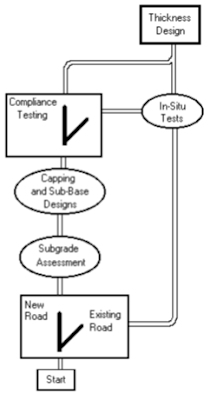 |
|
| Flowchart for pavement design using CBR method |
Scope and Objective of the CBR Test
Description of Apparatus
- Molds: Cylindrical mold with an internal diameter of 6 in. and a height of 7 in. with an extension collar of 2 in. height and a perforated base plate.
- Spacer Disk: A circular disk of metal 5 – 15/16 in. diameter and 2.416 in. height.
- Rammer: A rammer of mass 4.54 kg (10 lbs)
- Apparatus for measuring expansions. This consists of a swell plate with adjustable stem and a tripod support for a dial indicator.
- Surcharge weights: Several slotted or split metal plates of 149.2 mm; diameter and 5 lb weight.
- Penetration Piston: A metal Piston of circular cross – section having diameter of 1.954 in. Area = 3in2 and not less than 4 inches in length.
- Loading Device: A compression type apparatus capable of applying a uniformly increasing load up to 10,000 lb at a rate of 1.3 mm/min.Soaking Tank: A tank suitable for maintaining the water level of 1 in, above the top of specimen.
- Drying Oven: Oven Capable of maintaining a temperature of 110 + 5 0C for drying samples.
- Moisture content Containers
- Miscellaneous: Tools such as mixing pans, spoons, straightedge, filter paper, balances etc.
Test procedure
- Approximately 18 kg soil pass of 19mm sieve and retain of sieve no. 4 is taken.
- Moisture and dry density curve is obtained using the standard AASHTO T 99 or T 180.
- Optimum Moisture Content (OPC) is obtained from the graph between moisture content and dry density
- Prepare the sample by adding optimum moisture content and then compact the soil in five layers by applying 10,30 and 65 blows respectively in three CBR molds using 10 lb rammer having 18 in. height of fall. The compacted densities of the three specimens range from 95 percent to 100 % of the maximum dry density already determined by the T 180 compaction test.
- Soaking: Place the swell plate with adjustable stem on the soil sample in the mold and apply sufficient annular weights to produce an intensity of loading equal to the mass of sub-base and base courses and surfacing above the tested material, but not less than 4.54 kg (10 lbs) . Place the tripod with dial indicator on top of the mold and make an initial dial reading.
- Immerse the mold in water to allow free access of water. Place the sample in water for 96 hours (4 days)
- Make a dial reading on soaked specimen and calculate swell as a percentage of initial sample height.
- Remove the sample from tank and allow to drain for 15 minutes.
- Penetration Test: Place the mold on the loading frame and adjust its potion until the piston is centered on the specimen.
- Seat the penetration piston with a 44 N (10 lb) load, and set both the load dial and the strain dial to zero. This initial load is considered as the zero load when determining the stress-penetration relationship.
- Place the surcharge weights on the specimens equal to that used during soaking. Apply load at a rate of 1.3 mm / min and record the load for penetration of 0.025 in, 0.05 in, 0.075 in, 0.10 in and so on up to 0.5 inches.
- Stress strain curve: Plot curves between load and penetration for each specimen. Apply the corrections to the curves if required. Take the readings of load for 0.1 in and 0.2 in. penetration and find CBR for both penetrations. The greater values is the required CBR for that specimen. Also find the dry density for each specimen.
- CBR = Test load value, divided by, the standard load, multiplied by 100.
- Design CBR: it is calculated by plotting a graph between CBR values and dry densities of all the three specimens and then calculating the design CBR against value of 85 % maximum dry density.
Test results, table ,graphs and calculations
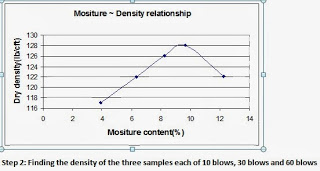 |
| Moisture Density Relationship |
|
Sample No.
|
Moisture Content (%)
|
Dry Density (lb/cft)
|
|
1
|
||
|
2
|
||
|
3
|
||
|
4
|
||
|
5
|
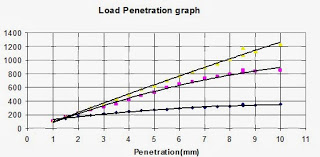 |
| Load Penetration Curve |
|
Sr.No
|
Load (lbs)
|
Penetration (mm)
|
|
1
|
0.5 mm
|
|
|
2
|
1.0 mm
|
|
|
3
|
1.5 mm
|
|
|
4
|
2.0 mm
|
|
|
5
|
2.5 mm
|
|
|
6
|
3.0 mm
|
|
|
7
|
3.5 mm
|
|
|
8
|
4.0 mm
|
|
|
9
|
4.5 mm
|
|
|
10
|
5.0 mm
|
|
|
11
|
5.5 mm
|
|
|
12
|
6.0 mm
|
|
|
13
|
6.5 mm
|
|
|
14
|
7.0 mm
|
|
|
15
|
7.5 mm
|
|
|
16
|
8.0 mm
|
|
|
17
|
8.5 mm
|
|
|
18
|
9.0 mm
|
|
|
19
|
9.5 mm
|
|
|
20
|
10 mm
|
|
Sr.No
|
Load (lbs)
|
Penetration (mm)
|
|
1
|
0.5 mm
|
|
|
2
|
1.0 mm
|
|
|
3
|
1.5 mm
|
|
|
4
|
2.0 mm
|
|
|
5
|
2.5 mm
|
|
|
6
|
3.0 mm
|
|
|
7
|
3.5 mm
|
|
|
8
|
4.0 mm
|
|
|
9
|
4.5 mm
|
|
|
10
|
5.0 mm
|
|
|
11
|
5.5 mm
|
|
|
12
|
6.0 mm
|
|
|
13
|
6.5 mm
|
|
|
14
|
7.0 mm
|
|
|
15
|
7.5 mm
|
|
|
16
|
8.0 mm
|
|
|
17
|
8.5 mm
|
|
|
18
|
9.0 mm
|
|
|
19
|
9.5 mm
|
|
|
20
|
10 mm
|
|
Sr.No
|
Load (lbs)
|
Penetration (mm)
|
|
1
|
0.5 mm
|
|
|
2
|
1.0 mm
|
|
|
3
|
1.5 mm
|
|
|
4
|
2.0 mm
|
|
|
5
|
2.5 mm
|
|
|
6
|
3.0 mm
|
|
|
7
|
3.5 mm
|
|
|
8
|
4.0 mm
|
|
|
9
|
4.5 mm
|
|
|
10
|
5.0 mm
|
|
|
11
|
5.5 mm
|
|
|
12
|
6.0 mm
|
|
|
13
|
6.5 mm
|
|
|
14
|
7.0 mm
|
|
|
15
|
7.5 mm
|
|
|
16
|
8.0 mm
|
|
|
17
|
8.5 mm
|
|
|
18
|
9.0 mm
|
|
|
19
|
9.5 mm
|
|
|
20
|
10 mm
|
Summary of CBR Test and conclusion
|
Sample No.
|
Compaction Effort
|
Dry Density (lb/cft)
|
CBR value (%)
|
|
1.
|
10
|
113
|
14.5
|
|
2.
|
30
|
121
|
28
|
|
3.
|
65
|
125
|
34.5
|
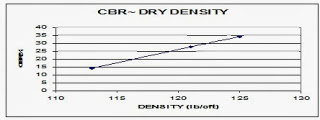 |
| CBR – Density Relation |
Limitations
Conclusion:
|
CBR VALUE
|
SUBGRADE STRENGTH
|
COMMENTS
|
|
3% and less
|
Poor
|
\” Capping is required
|
|
3% – 5%
|
Normal
|
Widely encountered CBR range capping considered according to road category
|
|
5% – 15%
|
Good
|
\”Capping\” normally unnecessary except on very heavily trafficked roads.
|

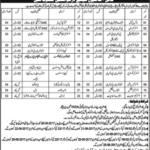















I am using Novo Formula and highly recommend it
I am using Novo Formula and highly recommend it